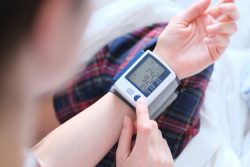How Much Exercise Is Too Much?
 Can a person exercise too much? We have always been told that exercising is good for a healthy body. But now studies are shedding some light on what is the optimum amount of exercise required to be healthy.
Can a person exercise too much? We have always been told that exercising is good for a healthy body. But now studies are shedding some light on what is the optimum amount of exercise required to be healthy.
A study in the Netherlands where the participants were active athletes that worked out to extreme levels has shown that they developed atherosclerosis in later years. The athletes cardiovascular health had been affected by the excessive workouts. Cardiovascular diseases are the leading cause of death globally so this can be a reason to worry. More study will be needed to see if this determination could relate to the general population that exercises regularly.
A recent report by the Cleveland Clinic in Ohio states that a regular exercise routine is beneficial. The participants in this study were monitored for 23 years after going through health tests. Researchers monitored and followed up on the health, exercise and lifestyle data from 1991-2014 to be able to make this determination. This conclusion was for all age groups that were on a regular exercise program.
Another study by Yale University found that a person that exercises every day for at least 90 minutes can improve mental health. To understand the association between exercise and mental health, this study centered on the type of exercise, duration, frequency and intensity. They also determined that no exercise at all or any exercise beyond the 90 minutes could be detrimental.
There is a difference between extreme workouts by athletes and regular exercising in general. And, not exercising at all was worse than excessive workouts. Dr. Wael, a cardiologist at the Cleveland Clinic noted that people that performed poorly on a treadmill or stress test were at a higher risk of death than even people that had diabetes, hypertension or smoked. The benefits of exercise far outweigh any risk in comparison to not exercising at all. He believes there is no ceiling on exercise that can benefit a persons health as long as it is not extreme. An example of extreme would be running 100 miles per week.
Everyone needs to exercise regularly to reach and maintain a high fitness level. This is especially true for older individuals. A persons cardiorespiratory fitness level is an indication of overall health and exercise can help to achieve a good outcome.
To view the original scientific study click below:
Association of Cardiorespiratory Fitness With Long-term Mortality Among Adults Undergoing Exercise Treadmill Testing



 New research has shown that increased levels of the omega-3 fatty acids EPA and DHA can improve your chances of living longer. The study published in The American Journal of Clinical Nutrition looked at over 2,000 people and what percentage of their total fatty acids are made up of EPA and DHA. This number then was used as their risk assessment. It turns out that the researchers found that the higher the level of omega-3 index was, the lower the risk.
New research has shown that increased levels of the omega-3 fatty acids EPA and DHA can improve your chances of living longer. The study published in The American Journal of Clinical Nutrition looked at over 2,000 people and what percentage of their total fatty acids are made up of EPA and DHA. This number then was used as their risk assessment. It turns out that the researchers found that the higher the level of omega-3 index was, the lower the risk.  Engaging in more steps daily, either in short spurts or all at once may help you live a longer life. This is according to preliminary research which will be presented at The American Heart Association’s Epidemiology, Prevention Lifestyle and Cardiometabolic Health Conference 2021.
Engaging in more steps daily, either in short spurts or all at once may help you live a longer life. This is according to preliminary research which will be presented at The American Heart Association’s Epidemiology, Prevention Lifestyle and Cardiometabolic Health Conference 2021.  New research by the Univ. of Colorado at Boulder shows how just 5 minutes a day practicing a procedure called strength training for your breathing muscles can improve a persons health dramatically. It can lower blood pressure as well as improve some measures of vascular health. It can also do this as well as medication or even aerobic exercise.
New research by the Univ. of Colorado at Boulder shows how just 5 minutes a day practicing a procedure called strength training for your breathing muscles can improve a persons health dramatically. It can lower blood pressure as well as improve some measures of vascular health. It can also do this as well as medication or even aerobic exercise. Stress affects a persons body in many ways. One of them is turning hair gray. A new study by researchers at Columbia Univ. Vagelos College of Physicians and Surgeons has now found that graying of hair can be linked to evidence of psychological stress.
Stress affects a persons body in many ways. One of them is turning hair gray. A new study by researchers at Columbia Univ. Vagelos College of Physicians and Surgeons has now found that graying of hair can be linked to evidence of psychological stress.  How do your genes affect aging? A recent study by researchers at the National Institutes of Health wanted to find out just how bacteria in health and disease controlled ageing. To do this, they fed antibiotics to fruit flies and then monitored their gene activity, including those that control ageing, throughout their life.
How do your genes affect aging? A recent study by researchers at the National Institutes of Health wanted to find out just how bacteria in health and disease controlled ageing. To do this, they fed antibiotics to fruit flies and then monitored their gene activity, including those that control ageing, throughout their life.  Exposure to pollutants, such as UV rays, industrial chemicals and hazards, cigarette smoke, and ozone can lead to production of free radicals in our bodies. Free radicals can interact with biomolecules, such as DNA or a protein causing damage that keeps them from working properly. This will damage a persons DNA and tissues and if not repaired can increase the speed at which a person ages. This is collaborated by a study from Eric E Kelley, a West Virginia Univ. researcher and the Univ. of Minnesota.
Exposure to pollutants, such as UV rays, industrial chemicals and hazards, cigarette smoke, and ozone can lead to production of free radicals in our bodies. Free radicals can interact with biomolecules, such as DNA or a protein causing damage that keeps them from working properly. This will damage a persons DNA and tissues and if not repaired can increase the speed at which a person ages. This is collaborated by a study from Eric E Kelley, a West Virginia Univ. researcher and the Univ. of Minnesota. It is well known that using sunscreen can help minimize sun damage and help a person stay in the sun longer. But what is sunscreen really made of and what does it do?
It is well known that using sunscreen can help minimize sun damage and help a person stay in the sun longer. But what is sunscreen really made of and what does it do? What is the secret to living to 100? Is there one? A team of researchers at the Center on Healthy Aging at the Univ. of Calif., San Diego created a study to find out. It’s participants were aged from 21 to 99 and over. The study concentrated on a number of small villages in Italy, where it was shown these people lived a long and healthy life. They decided to focus the study on the participants’ character traits instead of their diet and heredity.
What is the secret to living to 100? Is there one? A team of researchers at the Center on Healthy Aging at the Univ. of Calif., San Diego created a study to find out. It’s participants were aged from 21 to 99 and over. The study concentrated on a number of small villages in Italy, where it was shown these people lived a long and healthy life. They decided to focus the study on the participants’ character traits instead of their diet and heredity.  An unresolved argument can make a person feel emotionally stressed. But a study by the Oregon State University has shown that resolving an argument can erase or reduce almost all of the emotional stress associated with it. The study used data from the National Study of Daily Experiences that had surveyed more than 2,000 people about their experiences and feelings for 8 days.
An unresolved argument can make a person feel emotionally stressed. But a study by the Oregon State University has shown that resolving an argument can erase or reduce almost all of the emotional stress associated with it. The study used data from the National Study of Daily Experiences that had surveyed more than 2,000 people about their experiences and feelings for 8 days.